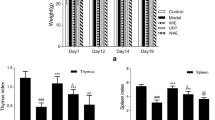Abstract
Seaweed Complex Preparation (SCP) is a clinical traditional Chinese medicine preparation which is composed of seven traditional Chinese herbs, and it has been used for treatment of lung cancer, liver cancer and digestive cancer. However, little information is available about the pharmacodynamic basis. The antitumor, immunomodulatory and free radical scavenging effects of SCP were evaluated in this study. Transplanted tumor in vivo method was used to determine the antitumor effect. The effects on splenocyte proliferation and phagocytosis of macrophages in tumor-bearing mice were measured by the MTT method and the phagocytizing cock red blood cell (CRBC) method respectively. The scavenging activities of SCP on DPPH and hydroxyl radicals in vitro were investigated. It was found that the medium-dose and high-dose of SCP could significantly inhibit the growth of transplanted hepatic tumor of murine hepatocarcinoma cell line H22, and promote proliferation of splenocytes and phagocytosis of macrophages. SCP possessed noticeable scavenging activities on DPPH and hydroxyl radicals. The antitumor effects of SCP might be achieved by improving immune system and scavenging free radicals, which is in accordance with the viewpoint of traditional Chinese medicine in promoting the body resistance and eliminating pathogenic factors for cancer treatment.
Similar content being viewed by others
References
Cao, Z. Y., Chen, X. Z., Liao, L. M., Peng, J., Hu, H. X., Liu, Z. Z., and Du, J., 2011. Fuzheng Yiliu Granule inhibits the growth of hepatocellular cancer by regulating immune function and inducing apoptosis in vivo and in vitro. Chinese Journal of Integrative Medicine, 17: 691–697.
Chen, X., Zhang, L., and Cheung, P. C., 2010. Immunopotentiation and anti-tumor activity of carboxymethylated-sulfated beta-(1–3)-D-glucan from Poria cocos. International Immunopharmacology, 10: 398–405.
Du, X., Chen, X., Zhao. B., Lv, Y., Zhang, H., Liu, H., Chen, Z., Chen, Y., and Zeng, X., 2011. Astragalus polysaccharides enhance the humoral and cellular immune responses of hepatitis B surface antigen vaccination through inhibiting the expression of transforming growth factor β and the frequency of regulatory T cells. FEMS Immunology and Medical Microbiology, 63: 228–235.
Ehrke, M. J., 2003. Immunomodulation in cancer therapeutics. International Immunopharmacology, 3: 1105–1119.
Fang, Y. C., Gu, Q. Q, Xin, X. L., and Zhang, X. N., 2000. Studies on the pharmacodynamics of algae preparation. Chinese Journal of Marine Drugs, 19: 18–20.
Fu, X. J., Liu, H. B., Wang, P., and Guan, H. S., 2009. A study on the antioxidant activity and tissues selective inhibiton of lipid peroxidation by saponins from the roots of Platycodon grandoflorum. American Journal of Chinese Medicine, 37: 1–9.
Gan, L., Sheng, S. H., Yang, X. L., and Xu, H. B., 2004. Immunomodulation and antitumor activity by a polysaccharide-protein complex from Lycium barbarum. International Immunopharmacology, 4: 563–569.
Han, S. B., Lee, C. W., Jeon, Y. J., Hong, N. D., Yoo, I. D., Yang, K. H., and Kim, H. M., 1999. The inhibitory effect of polysaccharides isolated from Phellinus linteus on tumor growth and metastasis. Immunopharmacology, 41: 157–164.
Hannasaki, Y., Ogawa, S., and Fukui, S., 1994. The correlation of between active oxygen scavenging and antioxidative effects of flavonoids. Free Radical Biology Medicine, 16: 845–850.
Jeong, J. C., Kim, J. W., Kwon, C. H., Kim, T. H., and Kim, Y. K., 2003. Fructus ligustri lucidi extracts induce human glioma cell death through regulation of Akt/mTOR pathway in vitro and reduce glioma tumor growth in U87MG xenograft mouse model. Phytotherapy Research, 25: 429–434.
Ji, Y. B., Gao, S. Y., and Cheng, B. C., 2001. Experiment study on antitumor function of Haimiding. Journal of Harbin University Commerce, 17: 11–12.
Ju, E. M., Lee, S. E., Hwang, H. J., and Kim, J. H., 2004. Antioxidant and anticancer activity of extract from Betula platyphylla var. japonica. Life Science, 74: 1013–1016.
Lee, S. J., Saiki, I., Hayakawa, Y., Nunome, S., Yamada, H., and Kim, S. H., 2003. Antimetastatic and immunomodulatory properties of a new herbal prescription, Bojung-bangam-tang. International Immunopharmacology, 3: 147–157.
Nie, X. H., Shi, B. J., Ding, Y. T., and Tao, W. Y., 2006. Antitumor and immunomodulatory effects of Weikangfu granule compound in tumor-bearing mice. Current Therapeutic Research-Clinical and Experimental, 67: 138–150.
Qi, L. F., and Xu, Z. R., 2006. In vivo antitumor activity of chitosan nanoparticles. Bioorganic & Medicinal Chemistry Letters, 16: 4243–4245.
Qiu, G., Zhang, M., and Yang, Y., 1999. The antitumour activity of total saponin of Clematis chinensis. China Journal of Chinese Material Medica, 22: 351–353.
Sasaki, S., Ohta, T., and Decker, E. A., 1996. Antioxidant activity of water soluble fractions of salmon spermary tissue. Journal of Agricultural and Food Chemistry, 44: 1682–1686.
Smirnoff, N., and Cumbes, Q. J., 1989. Hydroxyl radical scavenging activity of compatible solutes. Phytochemistry, 28: 1057–1060.
Stoner G. D., and Mukhtar, H., 1999. Polyphenols as cancer chemopreventive agents. Journal of Cellular Biochemistry, 22: 169–180.
Xu, H. S., Wu, Y. W., Xu, S. F., Sun, H. X., Chen, F. Y., and Yao, L., 2009. Antitumor and immunomodulatory activity of polysaccharides from the roots of Actinidia eriantha. Journal of Ethnopharmacology, 125: 310–317.
Yu, Y. G., He, Q. T., Yuan, K., Xiao, X. L., Li, X. F., Liu, D. M., and Wu, H., 2011. In vitro antioxidant activity of Bombax malabaricum flower extracts. Pharmaceutical Biology, 49: 569–576.
Zhang, J. C., Liu, L., Gong, Y. Q., Zheng, X. M., Yang, M. S., Cui, J. R., and Shen, S. G., 2009. Synthesis, characterization and antitumor activity of new type binuclear platinum (II) complexes. European Journal of Medicinal Chemistry, 44: 2322–2327.
Zhao, H. X., Li, Y. L., Wang, Y. Z., Zhang, J., Ouyang, X. M., Peng, R. X., and Yang, J., 2012. Antitumor and immunostimulatory activity of a polysaccharide-protein complex from Scolopendra subspinipes mutilans L. Koch in tumor-bearing mice. Food and Chemical Toxicology, 50: 2648–2655.
Author information
Authors and Affiliations
Corresponding author
Rights and permissions
About this article
Cite this article
Liu, X., Shao, C., Kong, W. et al. Evaluation of antitumor, immunomodulatory and free radical scavenging effects of a new herbal prescription seaweed complex preparation. J. Ocean Univ. China 12, 515–520 (2013). https://doi.org/10.1007/s11802-013-2017-z
Received:
Revised:
Accepted:
Published:
Issue Date:
DOI: https://doi.org/10.1007/s11802-013-2017-z




